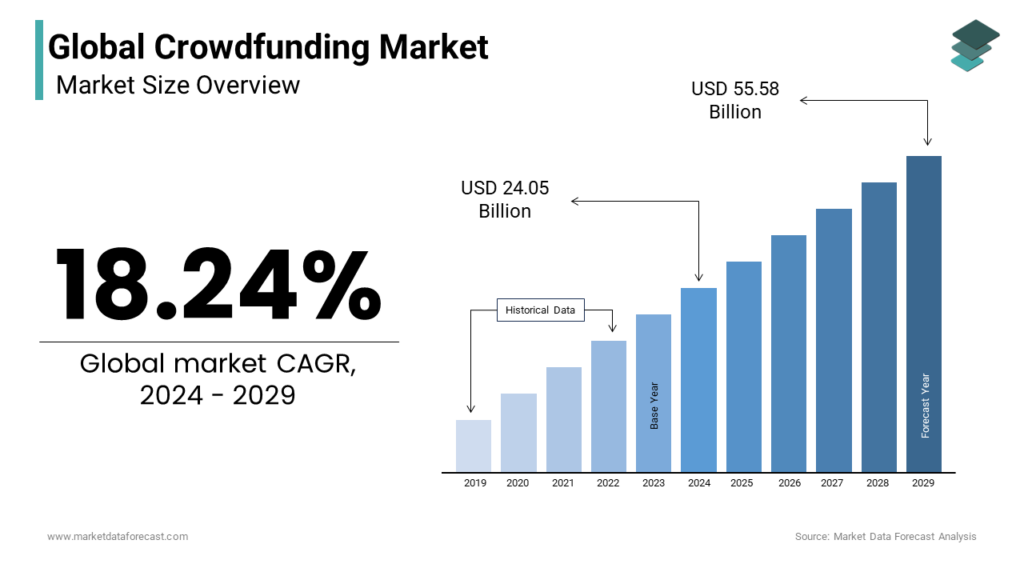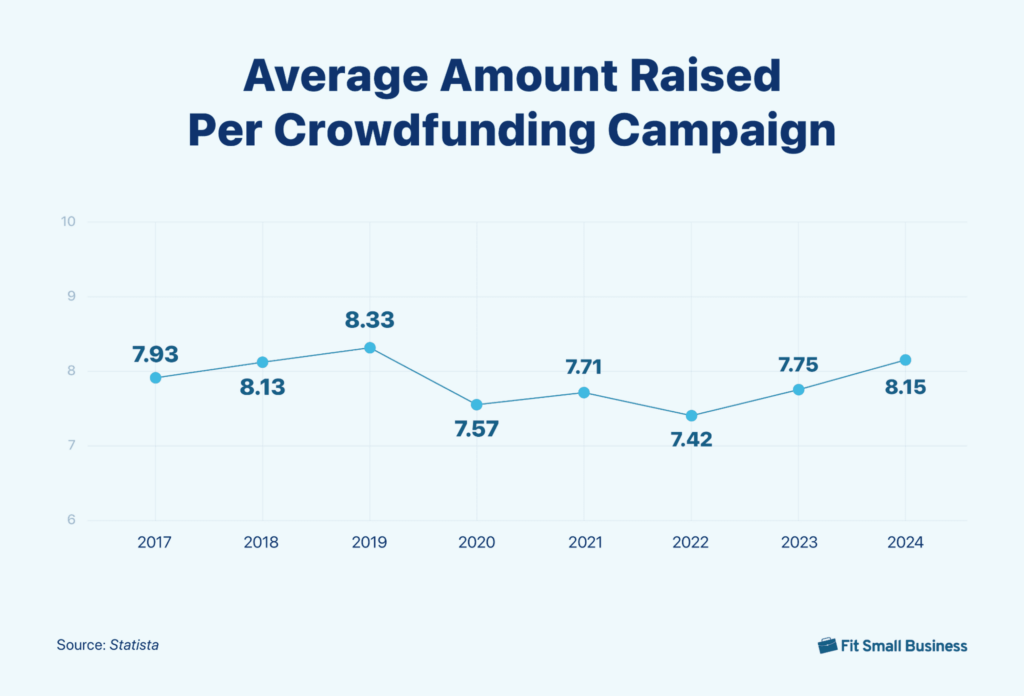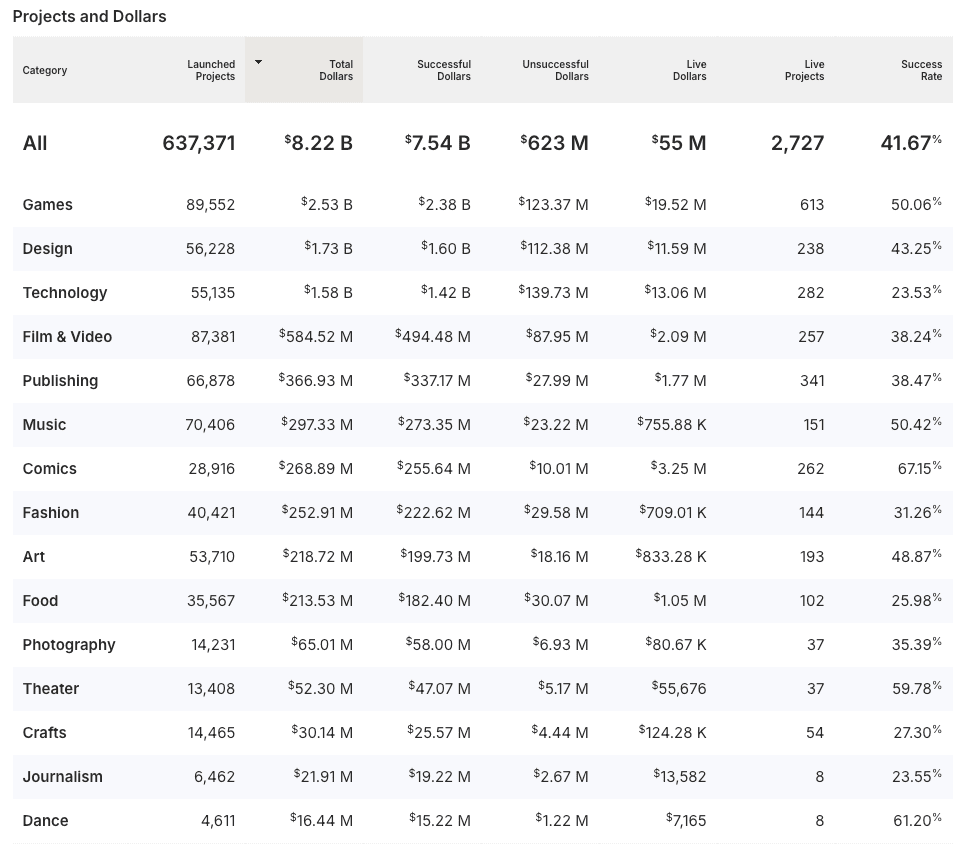Crowdfunding can be a valuable financial tool for businesses looking to raise money without taking out a traditional business loan. However, there are numerous factors that go into the success of a crowdfunding campaign, and we’ve compiled a list of important crowdfunding statistics that may help your fundraising efforts. These statistics include data referencing geographical popularity, year-over-year trends, and general characteristics of successful campaigns.
General Crowdfunding Statistics
1. In 2023, Crowdfunding Raised More Than $20.3 Billion
While crowdfunding may not be a traditional way to get money for your business, it is a popular one. In fact, 2023 data shows the crowdfunding market reached $20.3 billion.
If you’re currently considering raising money for your business via crowdfunding, it may be a solid option given the size of the market. It’s a testament that not only is there a large demand for businesses to gain more access to funding, but also that investors see the potential return on investment from high-potential companies.
(Market Data Forecast | 2024-2029)
2. Global Crowdfunding Market Size Is Expected to More Than Double by 2029
While historical data has shown that the crowdfunding market has grown, experts also forecast that this trend will continue. This is supported by data from Market Data Forecast, which estimates growth of nearly $55 billion by 2029. Notably, this represents annual growth of 18.24% between 2024 and 2029.
This continued expansion of crowdfunding popularity can be attributed to the presence of social media platforms. Bringing more attention and awareness to a company’s goals and needs through socials may help your business get more exposure to your cause. As the crowdfunding market grows, your business should be prepared to properly manage a campaign to compete with this continued level of growth.
Graph of the historical global market value of crowdfunding year-over-year (Source: Market Data Forecast)
(Market Data Forecast | 2024-2029)
3. In 2023, the US Had the Largest Market of Crowdfunding
Geographical location can play a large role in the number of sources you can get to partake in your crowdfunding campaign and ultimately impact your odds of success. According to data, the US led the market and raised the highest dollar amount in 2023, accounting for 40.8% of the global market share.
The main hotspots for crowdfunding globally include the US, Canada, The UK, Germany, France, China, India and Australia. For businesses residing in these countries, you may have more of an advantage and be able to reach a larger audience.
(Market Data Forecast | 2024-2029)
4. Average Amount Raised per Campaign Is Approximately $8.15K in 2024
So far in 2024, the average amount raised by a crowdfunding campaign is just above $8,000. On an annual basis, this amount has remained relatively consistent going back to 2017, with averages of $7,750 in 2023 and a high of $8,330 in 2019.
For businesses with a specific funding target, you should be prepared to manage expectations and to source funding from outside a campaign if your goals aren’t met.
(Source: Statista)
Business owners can use crowdfunding as one of several methods of getting more money. If you need additional capital, you can consider our recommendations for other types of startup business loans.
5. Less Than 25% of Campaigns Meet Their Funding Goals
Business owners should be aware that crowdfunding campaigns generally have a low success rate, and require a fair amount of effort to market a successful campaign. That said, only 23.9% of projects end up reaching their initial funding goal. This is based on data from 2014 through August 2024.
With such low success rates, business owners shouldn’t rely on crowdfunding as their main source of funding. You should research alternative financing options and have a backup plan to get funding elsewhere should you need to.
(The Crowd Data Center (Categories) | 2014-2024)
6. Successful Campaigns Have an Average of 341 Investors
When it comes to crowdfunding, there is strength in numbers. Looking only at crowdfunding campaigns that successfully reached the goal, there were over 300 unique investors who contributed money.
Getting funding from this many investors requires your campaign to have a wide reach. Additionally, business owners thinking of utilizing crowdfunding should have a plan for how to spread awareness and market the company’s product effectively.
(The Crowd Data Center (Projects) | 2014-2024)
7. Campaigns That Effectively Communicate Funding Goals Raise More Funds
Communicating your campaign can make or break your fundraising efforts. It should come as no surprise that campaigns that effectively market the product and communicate funding needs and next steps have a higher success rate. As evidence of this, there is data showing that businesses that provide a visual representation of their funding goals raise an average of 35% more than those that don’t.
Other methods you can consider to increase your chances of success include providing a video, as there is data to support that videos can help raise 150% more than if you opted to skip this step. Providing a summary to help potential backers more quickly and easily understand your funding needs can also help, as the average word count for successful projects has been shown to be between just 300 and 500 words.
(Nonprofits Source)
Platform-specific Statistics
8. Kickstarter Is One of the Most Popular Crowdfunding Platforms
Data from 2014 through August 2024 shows that Kickstarter is one of the most popular crowdfunding platforms available. According to Kickstarter’s stats page, it has more than 23 million backers, with over 8.1 million as repeat backers, and more than 97 million pledges made to crowdfunding campaigns. It has also raised around $8.2 billion in funding.
(Source: Kickstarter)
9. Kickstarter’s Most Popular Category for Crowdfunding Is Gaming
Kickstarter specializes in consumer-facing products, and gaming is its most popular category. It has over 89,000 projects related to gaming, raising more than $2.5 billion dollars, and an overall success rate of 50%. Other top-ranking categories on the Kickstarter platform include design, technology, film & video, and publishing.
Table of Kickstarter projects and dollars data as of August 2024 (Source: Kickstarter)
(Source: Kickstarter)
10. FundRazr Has the Highest Overall Success Rate
FundRazr is a crowdfunding platform for nonprofits, social causes, and professional fundraisers. While it’s not as popular as Kickstarter, it still has a large footprint, having raised more than $325 million across over 200,000 campaigns. Additionally, business owners utilizing FundRazr as a crowdfunding platform experience the highest overall success rate of 42.3%.
(FundRazr, The Crowd Data Center (Projects) | 2014-2024)
11. 47% of Indiegogo Campaigns Are Run by Women
Getting funding as an underserved business or community can be particularly challenging. If you fall into these categories, you may want to seek crowdfunding platforms that have shown a greater ability to provide assistance in some form, such as easier eligibility criteria, reduced documentation requirements, more market exposure, and reduced fees.
Indiegogo, for instance, may be a good crowdfunding platform to consider for women-owned businesses. Nearly half of its crowdfunding campaigns that exceed funding goals are run by women, which is significant considering the fact that only 22% of businesses are women-owned based on data provided by the Census Bureau.
(Indiegogo, United States Credit Bureau 2022 Annual Business Survey)
12. Indiegogo Has Over 10 Million Visitors Each Month
Crowdfunding platforms that cater to smaller communities or underserved businesses may have a more limited audience, which can impact the overall reach of your campaign. Indiegogo however, is considered an exception in this case, as it has over 10 million website visitors each month. It also offers funding to more than 235 countries & territories with approximately 19,000 campaigns each month.
(Indiegogo)
13. Wefunder Is the Top Equity Crowdfunding Platform
Different types of crowdfunding exist depending on the type of reward or incentive offered by a company. Equity crowdfunding allows you to raise funds in exchange for a portion of equity within your company. Based on the most recent data for 2023, Wefunder was the most popular equity crowdfunding platform in terms of number of investors and total funds raised.
(Kingscrowd, 2023)
Crowdfunding Industry Statistics
14. Technology Companies Have Raised the Most Amount of Funds
Taking into consideration multiple crowdfunding platforms, technology companies have been able to attract the largest amount of funding. In fact, successful technology crowdfunding campaigns have raised nearly $25 billion since 2014.
For technology companies, this data may be useful in determining your chance of success with crowdfunding. However, when choosing a crowdfunding platform to start a campaign, be aware that not all crowdfunding platforms are created equal, as some platforms may exhibit funding amounts far below these averages across various industries.
(The Crowd Data Center (Categories) | 2014-2024)
15. Comics and Graphic Novels Have the Highest Crowdfunding Success Rate
As mentioned previously, crowdfunding campaigns typically have a low success rate. Comics and graphic novels, however, see much more success with a nearly 61% success rate, more than double the average of 23.9%.
The business industry can play a part in the success rate of your crowdfunding campaign, and business owners should consider the average success rates of the industry their business operates in before pursuing this route.
(The Crowd Data Center (Categories) | 2014-2024)
16. Gaming Has the Greatest Number of Backers per Campaign
On average, crowdfunding campaigns centered around gaming projects have an average of 447 backers. When only taking successful projects into consideration, that figure increases to an average of 733.
This goes to show that successful campaigns can vary by project and that backers typically will invest in products or services that they themselves are interested in.
(The Crowd Data Center (Categories) | 2014-2024)
Frequently Asked Questions (FAQs)
The success rate of crowdfunding varies across platforms and has a variety of contributing factors. That said, less than 25% of campaigns meet their initial funding goal on average. It really depends on the audience, type of product, and campaign popularity that allow a business to reach its crowdfunding goals.
It can be effective if you launch a successful campaign and don’t want to take on debt with traditional financing methods. You can improve your chances of launching a successful crowdfunding campaign by providing a short description of the product, videos with additional information, and a visual representation of how much additional funding is needed to meet your goals.
While crowdfunding may be a financing solution for some, it may be difficult to come by if you don’t market your campaign properly or don’t meet your funding goals. Depending on the platform you choose, you also might be put in a situation where you don’t get to keep the funds raised if you miss the mark on your set goal. Crowdfunding also comes with a lot of competition, so it can be difficult to stand out depending on your industry.
Bottom Line
The above crowdfunding stats can offer insight into factors such as the average crowdfunding success rate, platform-specific characteristics, and year-over-year trends. With these statistics, you can better plan your crowdfunding campaign and market it accordingly to better increase your odds of success.
While success is never guaranteed, your chances should go up the more that you have in common with crowdfunding campaigns that have historically performed well. If you need to resort to additional methods of funding such as business loans, refer to our guide on how to get a small business loan to boost your chances of getting approved.
References: Market Data Forecast | 2024-2029, Statista, The Crowd Data Center (Categories) | 2014-2024, The Crowd Data Center (Projects) | 2014-2024, Nonprofits Source, Kickstarter, FundRazr, Indiegogo, United States Credit Bureau 2022 Annual Business Survey, Kingscrowd





